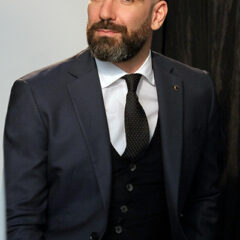The court case concerning the work “The Scent of the Night” by architect Chiara Biancheri (Lindelokse) and the use of it as a fixed set design for the 2016 Sanremo Film Festival has raised interesting questions about the protectability of digital works. In this article:
Sanremo 2016 set design and Arch. Biancheri's "Fiore Digitale"
As recently affirmed by the Italian Supreme Court, some issues related to the protection of so-called “digital art” remain unexplored and perhaps, for this very reason, are so fascinating.
The case in question concerns the graphic work “The Scent of the Night”, a digital flower created by Arch. Biancheri (Lindelokse), and the use of the same as a fixed set design for the 2016 Sanremo Festival.
In summary, according to RAI (Italian broadcasting corporation), the work had been used in good faith and in any case, since it was a digital work created through software, it could not have enjoyed authorial protection.
Architect Chiara Biancheri thus sued RAI, seeking recognition of her copyright in the work and compensation for damages.
The Court of Genoa had ascertained Biancheri’s authorship of the work and ordered RAI to pay damages and costs of the court proceedings. The judgment was also upheld at the appellate level. RAI then appealed to the Italian Supreme Court.
Let’s see what our Supreme Court decided in Order No. 1107/2023 and before that, let’s try to better understand what kind of work “The Scent of the Night” is and why it is being talked about so much.
The work "The Scent of the Night" and its protectability
The work “The Scent of the Night” sparked an interesting discussion on the issue of protectability of digital works and the assessment of their creative character.
Chiara Biancheri (Lindelokse), in fact, is a young architect with a passion for digital graphics. Among other activities, she is dedicated to the creation of so-called fractal images, using Apophysis software in the beginning and then improving the result through her taste, stylistic choices and other digital tools.
For the record, “a fractal is a geometric object endowed with internal homotety: it repeats itself in its shape in the same way on different scales, and therefore by enlarging any of its parts we obtain a figure similar to the original. Thus, fractal geometry is said to be the (non-Euclidean) geometry that studies these structures, recurring for example in the engineering design of networks, Brownian motion and galaxies” (the definition is from Wikipedia: https://it.wikipedia.org/wiki/Frattale).
The fractal structure consists of parts that repeat on different scales of magnitude. This means that if a small portion of the object is observed, it resembles its overall shape. Fractals are proper elements of many scientific disciplines, such as mathematics, physics and biology, but also in digital art. Since elements such as software and mathematical principles were exploited to make “The Scent of the Night”, some doubts have arisen about the protectability of the digital work in question. However, let us see what principles are provided by law in this regard.
The requirement of creative character in the context of copyright law
International copyright protection finds its main source in international treaties, the most important of which is the Berne Convention for the Protection of Copyright in Literary and Artistic Works. In our domestic legal system, the legal concept of creativity is regulated by Article 1 of Law No. 633 of 1941. In fact, copyright protects works provided that they are creative.
Creativity consists in the use of a free and discretionary mode of expression, recognizable by others as an original representation (real or imaginary). In other words, the creative character of the work does not concern the object represented or produced, but rather the modes of expression and representation used by the author of the work.
Article 1 of the Copyright Protection Law states verbatim that “intellectual works of a creative character belonging to literature, music, figurative arts, architecture, theater and cinematography, whatever the mode or form of expression, are protected under this law.”
Thus, if the author uses a personal and original form of expression to represent an object or situation, then the work should be considered creative and protected by copyright.
The Italian Supreme Court, in the judgment under review, had the opportunity to recall its well-established guidance in this regard: “creativity cannot be excluded merely because the work consists of simple ideas and notions, included in the intellectual patrimony of persons having experience in the subject matter; moreover, creativity is not constituted by the idea in itself, but by the form of its expression, that is, by its subjectivity, so that the same idea may be the basis of different works, which are or may be different because of the subjective creativity that each of the authors expends and which, as such, is relevant for the purposes of protection (Sec. 1, No. 25173, Nov. 28, 2011; Sect. 1, No. 21172, Oct. 13, 2011; Sect. 1, No. 20925, Oct. 27, 2005).”
What happens, however, when creativity is supported by the use of software and the result is, specifically, a fractal? Let’s see how our Supreme Court has ruled on this issue.
Creativity required for digital works according to the Italian Supreme Court (ord. 1107/2023)
The Supreme Court (Cass. Civ., sec. I, ord. no. 1107/2023) has emphasized that the mere use of software does not automatically exclude protection of the work under copyright law.
The level of creativity of a work must be assessed on a case-by-case basis. The use of technological tools can help the artist in the creation process, but still does not seem to be able to fully replace his or her creative elaboration.
Therefore, in order to determine whether or not the work deserves legal-authorship protection, it is necessary to conduct a detailed analysis of the level of creativity and originality of the work, having regard for the software used and its specific weight.
In summary, the admission of use of software is not sufficient information to exclude the protectability of the work, and a more in-depth factual assessment is necessary to determine whether the use of the technological tool has completely absorbed the creative elaboration of the artist.
As the Court had unfortunately to declare some grounds of appeal inadmissible, it was unable to address the issues “…so far unexplored in the jurisprudence of this Court, of so-called digital art (also called digital art or computer art) as an artistic work or practice that uses digital technology as part of the creative process or exhibition presentation””
In summary, the Supreme Court’s ruling regarding the protectability of the work “The Scent of the Night”, through its invocation of the analysis of the work’s level of creativity and originality, underscores the importance of a thorough case-by-case evaluation in order to ensure greater legal protection in the increasingly digital and technological environment.
© Canella Camaiora S.t.A. S.r.l. - All rights reserved.
Publication date: 13 March 2023
Last update: 7 May 2025
Textual reproduction of the article is permitted, even for commercial purposes, within the limit of 15% of its entirety, provided that the source is clearly indicated. In the case of online reproduction, a link to the original article must be included. Unauthorised reproduction or paraphrasing without indication of source will be prosecuted.

Arlo Canella
Managing Partner of the Canella Camaiora Law Firm, member of the Milan Bar Association, passionate about Branding, Communication and Design.
